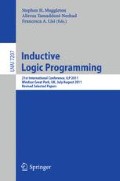Abstract
In this paper we demonstrate that machine learning (using Abductive ILP) can generate plausible and testable food webs from ecological data. In this approach, unlike previous applications of Abductive ILP, the abductive predicate ‘eats’ is entirely undefined before the start of the learning. We also explore a new approach, called Hypothesis Frequency Estimation (HFE), for estimating probabilities for hypothetical ‘eats’ facts based on their frequency of occurrence when randomly sampling the hypothesis space. The results of cross-validation tests suggest that the trophic networks with probabilities have higher predictive accuracies compared to the networks without probabilities. The proposed trophic networks have been examined by domain experts and comparison with the literature shows that many of the links are corroborated by the literature. In particular, links ascribed with high frequency are shown to correspond well with those having multiple references in the literature. In some cases novel high frequency links are suggested, which could be tested.
Access this chapter
Tax calculation will be finalised at checkout
Purchases are for personal use only
Preview
Unable to display preview. Download preview PDF.
References
Alexander, K.N.A.: The invertebrates of living and decaying timber in Britain and Ireland–a provisional annotated checklist. English Nature Research Reports 467, 1–142 (2002)
Bauer, T.: Prey-capture in a ground-beetle larva. Animal Behaviour 30(1), 203–208 (1982)
Bell, J.R., Andrew King, R., Bohan, D.A., Symondson, W.O.C.: Spatial cooccurrence networks predict the feeding histories of polyphagous arthropod predators at field scales. Ecography 33(1), 64–72 (2010)
Berg, K.: The role of detrital subsidies for biological control by generalist predators evaluated by molecular gut content analysis. PhD thesis, Universitäts-und Landesbibliothek Darmstadt (2007)
Desender, K., Pollet, M.: Ecological data on clivina fossor (coleoptera, carabidae) from a pasture ecosystem. ii. reproduction, biometry, biomass, wing polymorphism and feeding ecology. Rev. Ecol. Biol. Sol. 22(2), 233–246 (1985)
Dinter, A.: Intraguild predation between erigonid spiders, lacewing larvae and carabids. Journal of Applied Entomology 122(1-5), 163–167 (1998)
Lattin, J.D.: Bionomics of the nabidae. Annual Review of Entomology 34(1), 383–400 (1989)
Lindsey, J.: Ecology of Commanster, http://www.commanster.eu/commanster/insects/bugs/spbugs/saldula.saltatoria.html
Pons, X., Lumbierres, B., Albajes, R.: Heteropterans as aphid predators in inter-mountain alfalfa. European Journal of Entomology 106(3), 369–378 (2009)
Schaefer, C.W., Panizzi, A.R.: Heteroptera of economic importance. CRC (2000)
Sunderland, K.D.: The diet of some predatory arthropods in cereal crops. Journal of Applied Ecology 12(2), 507–515 (1975)
Sunderland, K.D., Lovei, G.L., Fenlon, J.: Diets and reproductive phenologies of the introduced ground beetles harpalus-affinis and clivina-australasiae (coleoptera, carabidae) in new-zealand. Australian Journal of Zoology 43(1), 39–50 (1995)
Toft, S.: The quality of aphids as food for generalist predators: implications for natural control of aphids. European Journal of Entomology 102(3), 371 (2005)
Turner, B.D.: Predation pressure on the arboreal epiphytic herbivores of larch trees in southern england. Ecological Entomology 9(1), 91–100 (1984)
Warner, D.J., Allen-Williams, L.J., Warrington, S., Ferguson, A.W., Williams, I.H.: Mapping, characterisation, and comparison of the spatio-temporal distributions of cabbage stem ea beetle (psylliodes chrysocephala), carabids, and collembolan in a crop of winter oilseed rape (brassica napus). Entomologia Experimentalis et applicata 109(3), 225–234 (2003)
Weber, D.C., Lundgren, J.G.: Assessing the trophic ecology of the coccinellidae: their roles as predators and as prey. Biological Control 51(2), 199–214 (2009)
Author information
Authors and Affiliations
Editor information
Editors and Affiliations
Rights and permissions
Copyright information
© 2012 Springer-Verlag Berlin Heidelberg
About this paper
Cite this paper
Tamaddoni-Nezhad, A., Bohan, D., Raybould, A., Muggleton, S.H. (2012). Machine Learning a Probabilistic Network of Ecological Interactions. In: Muggleton, S.H., Tamaddoni-Nezhad, A., Lisi, F.A. (eds) Inductive Logic Programming. ILP 2011. Lecture Notes in Computer Science(), vol 7207. Springer, Berlin, Heidelberg. https://doi.org/10.1007/978-3-642-31951-8_28
Download citation
DOI: https://doi.org/10.1007/978-3-642-31951-8_28
Publisher Name: Springer, Berlin, Heidelberg
Print ISBN: 978-3-642-31950-1
Online ISBN: 978-3-642-31951-8
eBook Packages: Computer ScienceComputer Science (R0)

